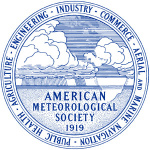- Industria: Weather
- Number of terms: 60695
- Number of blossaries: 0
- Company Profile:
The American Meteorological Society promotes the development and dissemination of information and education on the atmospheric and related oceanic and hydrologic sciences and the advancement of their professional applications. Founded in 1919, AMS has a membership of more than 14,000 professionals, ...
Any relatively flat piece of ice 20 m or more across. It may be composed of several fragments bonded together.
Industry:Weather
Any precipitation attributable to the action of a front; used mainly to distinguish this type from airmass precipitation and orographic precipitation.
Industry:Weather
Any process for determining the accuracy of a weather forecast by comparing the predicted weather with the observed weather of the forecast period. Principal purposes of forecast verification are to test forecasting skills and methods. Compare forecast evaluation.
Industry:Weather
Any particle immersed within supercooled water, initiating the growth of an ice crystal to be compared with particles nucleating directly from the vapor phase (deposition nucleus). Similar particles may nucleate at somewhat different temperatures (a few degrees) depending on the process. Observations of natural freezing nuclei indicate that there is normally present in the atmosphere a large variety of such particles with varying activation temperatures (temperatures at which they become effective nucleators). Certain bacteria from vegetation (pseudomonas syringae) nucleate ice at temperatures as high as −2°C; mineral particles (e. G. , clays: kaolinite and montmorillonite) at −10° to −20°C; artificial nuclei (e. G. , silver iodide, lead iodide, and metaldehyde), as smoke, can be found to nucleate at intermediate temperatures, i.e., −5° to −10°C. The origin, distribution, and composition of these particles is highly variable; some are composed of a mixture with a hygroscopic component that dilutes prior to nucleation of the water by the freezing nucleus.
Industry:Weather
Any ice that is or was once a part of a glacier. It has been consolidated from firn by further melting and refreezing and by static pressure. Firn becomes glacier ice once the pockets of air between individual ice grains are no longer interconnected. Glacier ice may be found in the sea as an iceberg.
Industry:Weather
Any measurement of an observed quantity that can be used to validate or verify a new (often remote sensing) measurement or technique.
Industry:Weather
Any form of liquid precipitation that freezes upon impact with the ground or exposed objects, that is, freezing rain, freezing drizzle, or freezing fog. Compare frozen precipitation.
Industry:Weather
Any form of precipitation that reaches the ground in frozen form, that is, snow, snow pellets, snow grains, ice crystals, ice pellets, and hail.
Industry:Weather
Any form of ice found floating in water. The principal kinds of floating ice are lake ice, river ice, sea ice that forms by the freezing of water at the surface, and glacier ice (ice of land origin) formed on land or in an ice shelf. The concept includes ice that is stranded or grounded.
Industry:Weather
